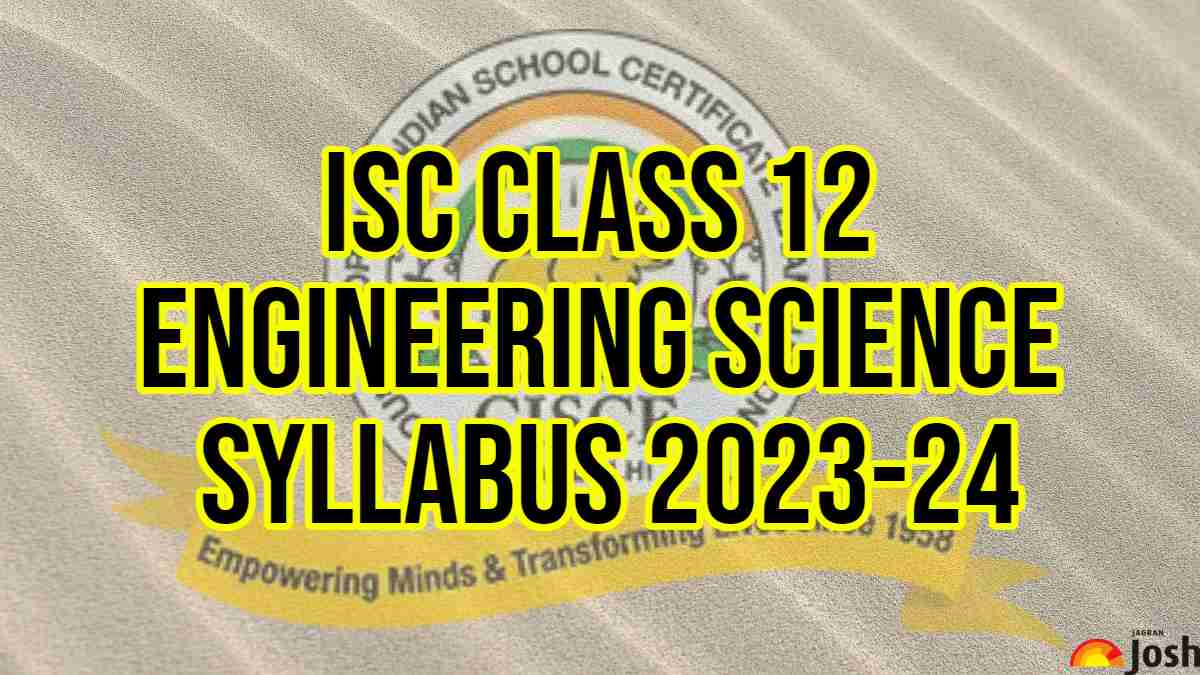Class 12 2023-24 Engineering Science syllabus ISC: CISCE is one of the educational boards that ensure the delivery of required education to the growing future minds. It nurtures students to make them blossom so that they can spread the scent of knowledge and positivity to the world around them. In this whole process, academics play a major role. Can you imagine studies without knowing what is to be covered? No! Right? When you don’t know what you need to do then it becomes difficult to prepare for a task to meet the highest standards. Lina Nilson once said “The syllabus is not a contract, but a compass. It sets the direction for the course and guides students through the content.” We believe you will agree to this.
To help you with your Engineering Science syllabus we have framed this article to give an elaboration on the ISC Class 12 Engineering Science syllabus 2023-24. As per the ISC guidelines, if you have opted for physics then your eligibility to opt for Engineering Science is compromised. To know more, continue reading the syllabus highlights.
ISC Engineering Science Syllabus Highlights
- This subject may not be taken with Physics.
- The syllabus is designed for candidates who have followed a course with a bias towards engineering.
- The examiners will attach importance to an understanding of scientific principles and will look for evidence that these have been studied practically. The examiners may ask to see the practical notebooks.
ISC Class 12 Engineering Science Syllabus Key Points
There will be two papers in the subject:
Paper I – Theory: 3 hours…… 80 Marks
Paper II – Project Work ……. 20 Marks
ISC Class 12 Engineering Science Syllabus 2023-24
|
PAPER I (THEORY): 80 MARKS |
|
|
There will be one paper of three hours duration of 80 marks. |
|
|
Part I of the paper will contain short answer questions, all of which are to be answered |
Part II of the paper will contain six questions of which candidates must answer five questions. |
Note: All questions will be set in the S.I. System. The unit abbreviations to be used in all question papers in this subject will be those contained in the Guide to the use of International System (SI) units SP; 5-1969 (Published by the Indian Standards Institution).
|
1. Strength of materials. Simple problems. Hooke’s law, stress and strain. Young’s modulus. Tension and compression. Elastic limit. Ultimate strength. Factors of safety. |
|
2. Friction. Conditions affecting friction. Lubrication. Conditions should include types of materials, their surface finish and wetness or dryness. |
|
3. Limiting friction. Coefficients of friction. |
|
4. Work. Work done by constant and by varying force; graphical representation of and calculations thereon. Energy, potential and kinetic. Conservation of energy and conversion into work, work done in rotation. Torque. |
|
5. Machines. Simple single-string pulley systems. Simple and differential wheel and axle. Weston pulley block. Screw jack. Worm (single start thread and wheel). Gear and belt drives. Velocity ratio, mechanical advantage and efficiency. |
|
6. Power. Simple treatment of steam and internal combustion engines. Indicators diagrams. Indicated mean effective pressure. Indicated and brake horsepower. Methods of measurement of power. Rope brake and Prony brake. Hydraulic power (as given by the product of constant pressure and rate of volume change). Mechanical efficiency. Relationship between rev/min and working strokes per minute in double-acting steam engines and in two and four-stroke internal combustion engines. The oscillating cylinder steam engine is not required. |
|
7. Momentum. Conservation of momentum, including rate of change of momentum and relationship with mass and acceleration. Knowledge of the coefficient of restitution is not required. |
|
8. Magnetism. Magnetic properties of iron and steel. The magnetic circuit; qualitative treatment only, with examples from transformers and machines. The compass needle. Magnetic effect of current in straight wire, single turn coil and solenoid, treated qualitatively. Electromagnets and their simple applications. Relation of direction of current in conductor and lines of magnetic force applied. Examples of the application of electromagnets to include electric trembler bell and relay. |
|
9. The simple circuit. Conductors and insulators. Electromotive force, potential difference, current, quantity and resistance; the volt, ampere, coulomb ampere-hour and ohm. Ohm’s law. Measurement of resistance, including Wheatstone bridge, Resistivity. Resistors in series and in parallel. |
|
10. Heating effect of current. Energy and power. Conversion of electrical to mechanical energy and vice versa. The joule, watt, and kilowatt-hour. Simple applications of heating effect. Effect of temperature on resistance. Temperature coefficient. Examples to include various domestic heating appliances and filament lamps. |
|
11. Chemical effect of current field. Electrolytes. Electrolysis. Electrochemical equivalent. Production of current by chemical action. Simple voltaic cell. Primary and secondary cells. Polarisation: prevention and removal. Cells in series and in parallel. Chemical equations are not required. |
|
12. Current-carrying conductor in magnetic field. The D.C. motor including series and shunt windings. Galvanometers, voltmeters and ammeters. Shunts and multipliers. A qualitative treatment of multiple D.C. motors is included. |
|
13. Electromagnetic induction: the laws of induction. Back e.m.f. of motor. Starting resistance for D.C. motor. Simple a.c. and D.C. generators. Relation of direction of lines of force, motion of conductor and current in coil. Eddy currents. Transformers. The induction coil; the coil ignition system. A qualitative treatment of multipole D.C. generators is included. |
|
PAPER II (PROJECT WORK): 20 Marks |
In addition to the syllabus prescribed above, candidates are also required to be assessed in Project Work.
PROJECT WORK FOR CLASS XII
The Project work will be assessed by the subject teacher and the Visiting Examiner appointed locally and approved by the Council.
All candidates will be required to have completed two projects from any topic/s covered in theory.
Mark allocation for each project (10 marks) :
|
Criteria |
Marks |
|
|
1 |
Title of the Project and Introduction |
1 |
|
2 |
Content |
3 |
|
3 |
Presentation and originality |
2 |
|
4 |
Conclusion/Comments/Summary |
1 |
|
5 |
Viva-Voce |
3 |
|
Total |
10 |
|
List of suggested assignments for Project Work:
- Show mathematically that the energy of a simple pendulum is conserved. Also draw and interpret the following for the same:
- displacement-time graph
- kinetic energy-displacement graph
- potential energy-displacement graph
- total (mechanical) energy and displacement graph.
- Study and represent graphically the work done on a body of mass m under the action of a constant force and by a varying force. Show calculations and discuss.
- Study the fundamental forces in nature governing the diverse phenomena of the macroscopic and microscopic world. Discuss the progress related to the unification of these forces.
- You have studied about the strength of materials. In this context, discuss the following:
- Stress and strain, their types, Hooke’s law, Young’s modulus, elastic limit, permanent set and ultimate strength.
- Take a stress-strain curve for a metal and mark the relevant points on the graph.
- Is it correct that a material that stretches more is more elastic? Discuss with examples.
- Observe any five surfaces at home:
- Which surface produces more friction and which produces less friction (on the basis of type of material, surface finish, dryness/wetness). Discuss giving reasons.
- Frictional force opposes the relative motion (impending or actual) between two surfaces in contact. Discuss. Also, show graphically the relation between the force applied F and force of static friction fs, / force of kinetic friction fk for any pair of surfaces in contact.
- A block of wood is given a push which slides along a horizontal, flat table surface, coming to a stop. Discuss what happens to the momentum of the block?
- A ball rolls without slipping on a perfectly flat plane of infinite extent. Will it roll forever? Discuss.
- Discuss the advantages and disadvantages of friction in daily life.
- Observe ten articles at home (five simple machines and five articles in which a combination of machines is being used) such as plier, scissors, knife, cycle/motorcycle, ramp, steering wheel, roller of the cord for blinds, juicer/mixer/blender, etc. For each of the articles selected:
- Identify the type of machine/s used.
- Draw simple diagrams for each item selected and mark the load, effort and fulcrum. Write expressions for mechanical advantage, velocity ratio and efficiency.
- Discuss briefly the utility of each type of machine used.
- Study the electricity bills of your home issued by the electricity department from January to December. Prepare a month wise analysis of units of electricity consumed and bill paid in a tabular form. Represent the same graphically. Suggest some ways in which you can economise electricity consumption at home.
- Observe a transformer installed in your locality and draw its labelled diagram. Discuss the principle on which it works and the reasons for energy losses. Find out the transmission and distribution mode of electrical energy from a power plant to a consumer. Discuss its pros and cons.
- Assemble a household circuit comprising three bulbs, three on/off switches, a fuse, and a power source from the given materials (Three bulbs (6V,1W) each, main switch of a power supply (battery eliminator), three switches, fuse (0.6A), connecting wires with red and black plastic coating, fuse wire, a plier and a cutter). Draw a circuit diagram of the actual layout and write the theory and procedure involved.
NOTE: No question paper for Project work will be set by the Council.
Also read:


